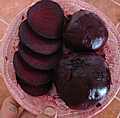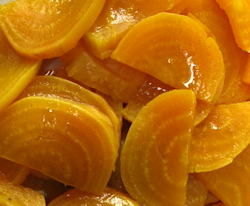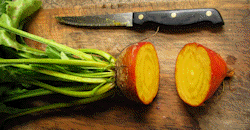~ BEETROOT Seed ~
Beetroot are an easy vegetable to grow and take about 90 days to mature:
Small screen: Turn your device sideways to view sowing calendar.






















































 = normal sowing & harvest time
= normal sowing & harvest time![]()
 = also possible depending on conditions
= also possible depending on conditions
 'Albino' White Beetroot
'Albino' White BeetrootNot just a novelty, this pointy white beetroot is great - no more red stains all over the kitchen. The flavour is just as normal. It is also the most productive and quick-growing beetroot we have found.
Although known since Roman times, this is an improved modern variety for home gardens, and dual-purpose - the succulent green leaves have been bred for use as leaf beet or chard. We often pick the beet in the morning, cook the leaves at lunch, & eat the root for dinner.
White beetroot. Leaves also particularly good to eat
![]() approximately 250 seed
£
approximately 250 seed
£

 Sanguina Beetroot
Sanguina Beetroot
The name means "Bloody". If you do want a good traditional, deep blood-red beetroot, this is the one.
Large conical roots, with intense red flesh, very juicy and sweet. This special strain from Italy is the most productive red beetroot we have found. Tender even when huge - lots of people have written in to say how much they like it.
Very large conical roots. Tender, no woodiness. Deep red.
![]() approximately 250 seed
£
approximately 250 seed
£


‘Golden Detroit’ Yellow Beetroot
We really love this variety. Yellow beets used to be widely grown, this is a really vigorous, quick-growing yellow beet from 1828 that makes round, bright yellow roots. It is tender and very sweet.
Although it is of course very nice cooked and sliced, that's not all you can do with beetroot. Here we have also made a raw grated beet and carrot salad, served with pasta & fresh basil pesto , chadwick cherry tomatoes, and garnished with edible borage flowers. (You'll find all the ingredients in the catalogue apart from the pasta) It's the yellow in the middle - what a great colour:
Beautiful & very productive yellow beetroot. Edible leaves.
![]() approx 200 seed
£
approx 200 seed
£

In 2014 Tom Hartley brought us back lots of seeds from Kazakhstan, including several beetroot, and we grew them all out to see what they were like. We did a blind taste-test, trying them all unlabelled, and this one came out as the best-flavoured every time.
It was then a two-year project to bulk it up and produce seed; we grow it, harvest the beet, check for the right size and shape, replant the good ones and then they make seed the following spring.
Here it is then for you to try; our favourite of all the beetroot varieties Tom brought back - a good deep flavour, medium sweet flesh, and a consistent shape with sturdy growth.
Tasty rare beet from Kazakhstan. Just a few hundred packets available each year.
![]() approximately 200 seed
£
approximately 200 seed
£
Saving your own Beetroot Seed:
Beetroot seed is fairly easy, provided you don't have any chard or leaf beet flowering nearby.
Beetroot flower in their second year, so you need to
either leave them in the ground overwinter,
or dig up your beetroots in Autumn. Lay them all out so you can compare
them, and select the best 12 - 16 roots:
- Make sure you choose ones that are true-to-type: right colour, shape & size.
- If your area has cold winters, store them in sand or
sawdust in a cool but frost-free place, and plant out in spring.
(the ideal storage is about 5-10 C and 95% humidity). Otherwise in milder areas, replant them straight away where you want them to grow. - You can plant them outside, but you will get much more seed if you plant them in a polytunel.
- The next summer they will flower (to about 5 foot high!).
They will probably need staking so that they don't fall over.
Remember, that they will cross with any other flowering beetroots, chard or leaf beet nearby. The flowers are wind pollinated. - Your seed will be ready in late summer. Just rub
the seed off when it is mostly brown.
You will get huge amounts of seed: dry it well, and it will be good for 3 or more years.
Above you can see a good trick with beetroot or chard
seed. Our rubber door mat has holes in it.
We just stomp on the dry seed-stalks , then roll back the mat and sweep
up the seed.
To clean the seed free from dust and debris, see our Winnowing Instructions in the Seedsaving table on the left.








